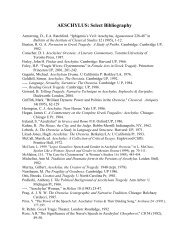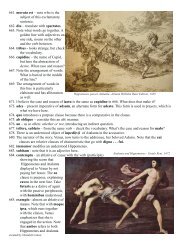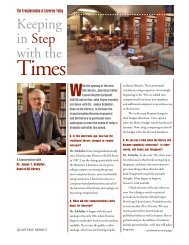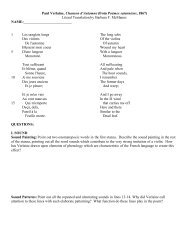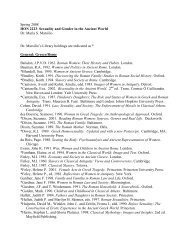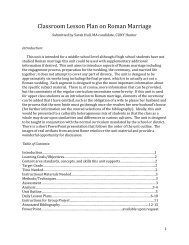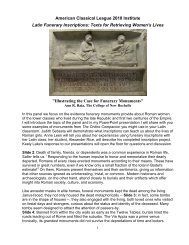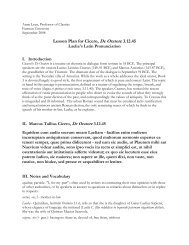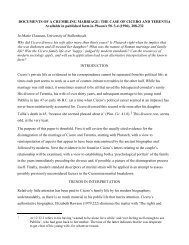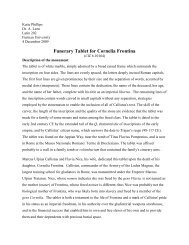Worksheet
Worksheet
Worksheet
Create successful ePaper yourself
Turn your PDF publications into a flip-book with our unique Google optimized e-Paper software.
INS 400 CDD: Viewpoints: The Feminine Archetype March 7, 2006Dr. A. RaiaCLASS DISCUSSION WORKSHEETUnit 2: Matriarchal/Patriarchal Consciousness and ValuesA. Gender Dualism: 2/16-2/28Readings I:Dr. McManus, Notes: Gender Attitudes of Consciousness (syllabus link)D.Wehr, Jung & Feminism, Ch. 2, pp. 13-25J. Singer, Androgyny, pp. 218-224--Jung posited that the psyche is structured in polarities of opposites which have beencharacterized in gender terms. But the power of symbols is such that these terms have enteredthe consciousness as mutually exclusive world views that affect thought and behavior, havebeen projected on real people and are the basis for social institutions. Sexism is a world viewthat leads to misogyny and oppression (internal & external).--Jung’s intuition that the polarities of the psyche are not static and hierarchical butinteract and thus produce psychic energy has been validated in brain research that hasdiscovered two primary modes of consciousness, the active and receptive, and twoareas responsible for different capacities, left (intellectual, verbal, analytic) and right(motor and spatial) that interact regularly in daily activity and are not sex linked.--Jungian archetypes are not gender-specific: each set of symbols offers potential fordevelopment in each sex. Androgyny is the resolution of dichotomies (scientific/ mythical)and hierarchies (dominant/subordinate) by bringing androcentrism to consciousness andrejecting limiting beliefs about the natures of men and women.Readings II:P.Young-Eisendrath, “Myth & Body: Pandora’s Legacy in a Post-ModernWorld”A. Baring & Cashford, Preface, pp. xi-xv, Ch. 13 "Eve: The Mother of AllLiving" in The Myth of the Goddess, pp. 486-546C. Christ, "Why Women Need the Goddess" in Womenspirit Rising, pp. 273-287.--ancient myths are metaphors and connect to archetypal meanings of universal emotions,which we must understand to understand ourselves. Primary (at birth): joy, sadness, fear,aggression, disgust, curiosity; Secondary (self-conscious,18 mos): shame, pride, envy, guilt,embarrassment. What can the Pandora myth tell us about culturally determined views ofwomen and beauty? Are their other interpretations possible?-- What is the myth of the Goddess? Expression of the sanctity & unity of life, resolution ofpolarities of human/nature, mind/body, intellect/intuition, spirit/matter, reason/instinct. Whatpositive images are associated with her: cycle of life, birth from the sea, spinners of fate, sacred
whole. With the sacred marriage of god & goddess comes rebirth, continuity, complementaryrelations of feminine/masculine.-- Applications to Eve, Lilith, Pandora, Mary, women encompassing Greek myth, Judaeism,Christianity, Islam and resulting in oppression. How else might their story be told, usingimages of the tree of life, the jar of ills, the curse, the serpent, the Fall?--“Religion fulfills deep psychic needs by providing symbols and rituals that enable people tocope with limit situations in human life (death, evil, suffering) and to pass through life’simportant transitions (birth, sexuality, death).” Christ 274--“Symbol systems cannot simply be rejected, they must be replaced.” Christ 275--Significance of the Goddess: female identification with power & creativity:1. Goddess symbols in ancient Mediterranean, native American, Hindu, Africantraditions2. Affirmation of body and life cycle3. Personification of energy in natural & human worlds, valuation of initiative andassertiveness in relational context4. Reevaluation of woman’s relationships (esp. mo-daughter, friends) and heritageB. Importance of Reinterpreting & Reclaiming Archetypal Symbols: 2/28-3/2Readings:Slide Images of Gender Symbolism: Class Analysis and DiscussionResponses to the Challenge (http://cnr.edu/home/bmcmanus/compare.html)H. Haste, The Sexual Metaphor, "Reclaiming the Symbols," pp. 188-203--Cultural dualism reflects anxieties: harder to change--Authentic self-definition for women: subject not object, equal treatment, experienceacknowledged, voice-- Otherness is negation; pluralistic perspectives needed--Apollonian & Dionysian: organizing structures which are not antithetical, need not involvecontrol and mastery--deconstruct & reconstruct metaphors of masculine/feminine relationship--Strategies:1. Challenge & disprove schema (ethos of manliness, flight from feminine)2. Redefine the meaning or significance of a symbol by learning about it, understandingthe anxieties, setting it in new contexts of the consciousness--Note cosmologies that show cooperation not contest between the male/female-- boys’ & girl’ learned behavior proliferate the status quo
A. Ulanov, “Descriptions of the Feminine” in The Feminine in Jungian Psychologyand in Christian Theology, pp. 137-167.-- Psychology’s Description of the Feminine:Biological (“anatomy is destiny”),Cultural (custom & habit created dependence and passivity),Psychic (Jung: not confined to female; use of symbol & myth; personal wholeness canonly come from an awareness of *Contrasexuality*; he acknowledged sex differences:difference doesn’t = discrimination; task of life is individuation, wholeness,reconciliation)-- Male must integrate his Anima: relatedness, valuing, feelings, involvement-- Female must integrate her Animus: logos, objectivity, judgment, abstraction-- Feminine Principle has two aspects:Elementary (static): Gestates, stable, darkPositive: Good Mother Negative: DestroyerTransformative (dynamic): involvementPositive: Creator, Inspirer Negative: Animalistic possessorCosmogonic Myths: comparison of the following Creation stories for examplesHopi creation myth (xerox),Genesis.1-2 (King James) ,Hesiod’s Theogony: text < http://omacl.org/Hesiod/theogony.html>, outline:Unit 2 Project on Reclaiming the Symbols: due March 211. Reread Haste, "Reclaiming the Symbols," pp. 188-203, paying special attention to thestrategies she suggests for “deconstructing and reconstructing the various metaphors ofthe relationship between masculine and feminine”(193):a. replacing the old symbol with a new oneb. redefining the meaning or significance of the old symbol2. Browse Voice of the Shuttle: Women’s Studies & Feminist Theory: http://vos.ucsb.edu/(check “About”), a comprehensive site of links, looking for an image or symbol-richsite that provides a good example of either reinforcing the old symbols or reclaimingthe symbols in the way that Haste recommends.3. Select a few pages from the web site that offers the best demonstration of eitherreinforcing the old symbols or reclaiming the symbols.4. Analyze the site as follows, depending on which category you choose:a. If Reinforcing: explain what strategies you would use to change and reclaim thesymbols in ways that are more authentic for womenb. If Reclaiming: explain what strategies have been used to change and reclaim thesymbols in ways that are more authentic for women



